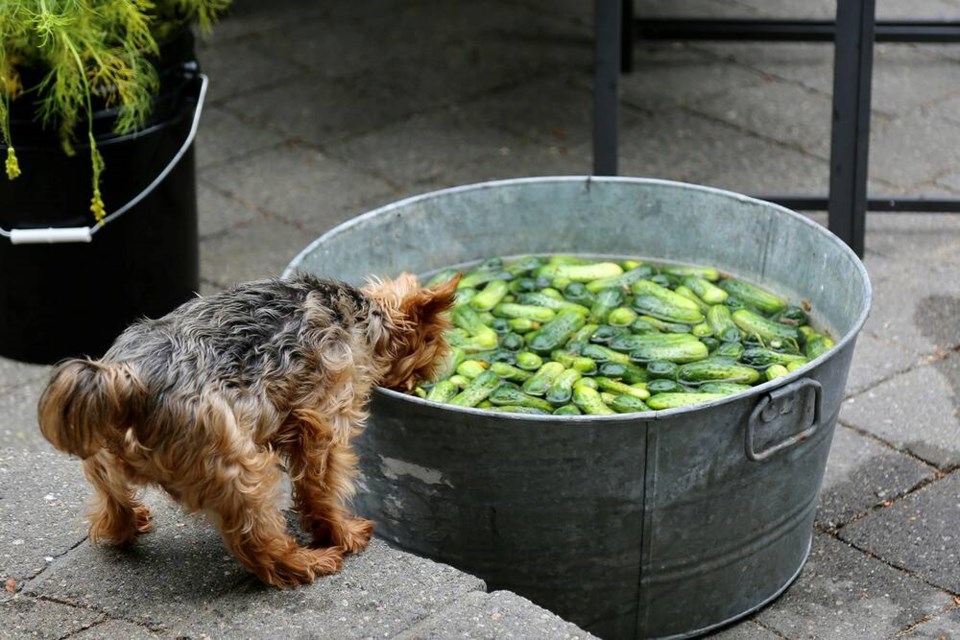Pickles – “Pickle Wickles” to be precise – have become a friendship currency of sorts in our family.
Typically we put up 60 quarts of smallish, triple garlic, slightly spicy, super dilly cucumber pickles. The doing of it is a season-long, labour-of-love undertaking that starts about now, and ends early in August when masses of not-too-big pickling cukes become ripe for the picking.
It is impossible for me to grow enough just-so sized, uniformly ripe cucumbers to satisfy 60 quart jars of Pickle Wickles on processing day. So, similarly to canning tomatoes, I purchase in bulk from local farmers.
In our home garden I grow Artist Gherkin, Early Green Cluster (1700s’), and Cool Customer cukes for eating fresh, and for small-batch pickling and lacto-fermenting. We regularly pickle carrots, beets and radishes as well.
At the moment, our cukes, carrots and beets are pushing up through three-quarter-inch cubes of living soil, under lights in our pantry. Germinated cubes will be potted-up into two-inch soil blocks. And then, long before their delicate tap roots gain purchase, the carrots and beets will be transplanted gently into two-inch dibbles in our raised beds. The cukes will move outside to the unheated greenhouse, waiting for gentler weather.
Elsewhere in the garden, tiny hot peppers, dill, garlic, fennel and myriad herbs used in small-batch pickling grow annually or perennially, here and there as I place them, or as they see fit. I have observed over time, that self-sown herbs are more resilient and consequently perhaps, more delicious than those I assign space to.
Large-batch pickling of cucumbers was inspired by my friend Kim, whose century farmhouse woodstove figured prominently in recollection. Kim raised her family in the country and, together with her friends pickled cucumbers annually, storing them on creaky wood shelves in their earthen-floored cellar. The imagery alone, had me hooked.
Kim shared her pickling trials, along with the recipe she had perfected after nine, not-quite-right incarnations. The most delightful share was her deliberate, somewhat prayerful way of wrapping tiny dill blossoms into folded bundles for stuffing between the glass and the cucumbers.
My youngest daughter, who was with us at the time but is now grown, will travel home from Victoria where she now lives, specifically to fold and wrap dill for Pickle Wickles.
Years after initiation, the recipe has evolved slowly to reflect my habit of layering aromatics and intensifying flavours.
A mise en place of Champagne vinegar heated with home-grown grape leaves for tannin, sea salt, copious amounts of fresh garlic sliced to increase surface area, tiny hot red and habanero peppers, and four types of dill – sundried weed, baby fresh, whole seeds, and of course the much-loved blossom bundles. Those, set up on the canning table outside the kitchen door, illustrate high summer.
At ground level, Veggie Dog Dave steals and ravages a dozen or so cukes from their galvanized ice bath. We pretend to scold him, and he scoots away leaving cucumber shrapnel in his wake. I dread the day when 14-year-old Dave isn’t able to help. This summer I will let him eat his fill.
By days end, the canning table groans under copious jars bejewelled with aromatics and bundled dill blossoms pressed up against the glass, wrapped in love, tradition and intention shared generously between friends, family and generations.
It has become a custom in our family to gift Pickle Wickles to friends, hosts, mentors, neighbours, favours and the people who make our lives better. Sixty quarts go quickly.
Laura Marie Neubert is a West Vancouver-based urban permaculture designer. Follow her on Instagram @upfrontandbeautiful, learn more about permaculture by visiting her Upfront & Beautiful website or email your questions to her here.
For a taste of permaculture, watch the video below:




